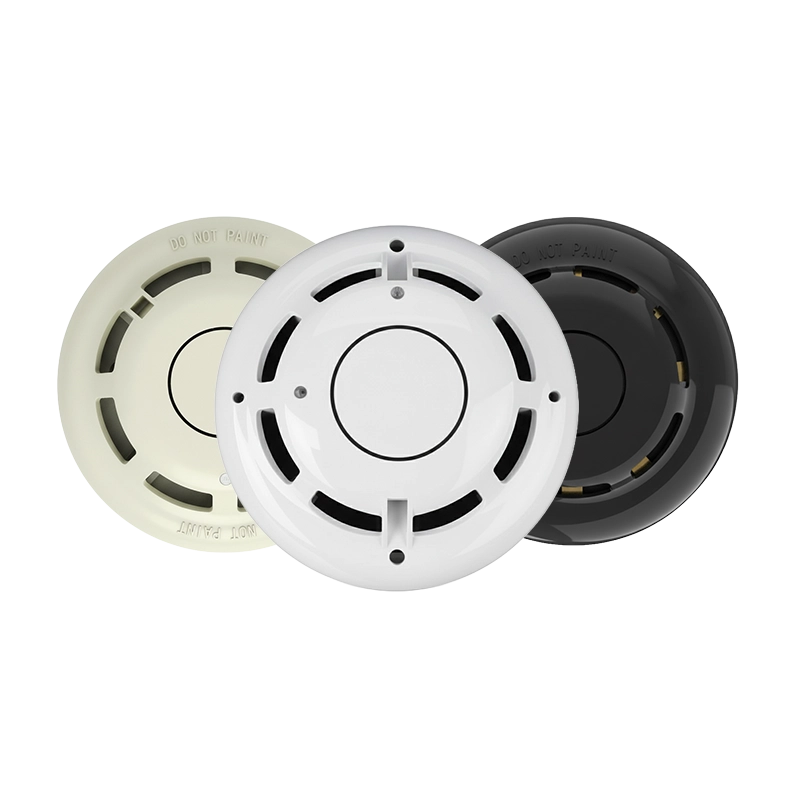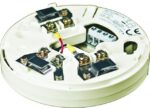Hochiki ESP Addressable Heat Detector
Summary
The Hochiki ATJ-EN is an advanced analogue addressable multi-heat sensor that provides versatile and reliable fire detection by incorporating both fixed temperature and rate of rise thermal sensing elements within a single device. Fully compatible with Hochiki’s ESP (Enhanced Systems Protocol) Analogue Addressable Protocol, this intelligent sensor offers flexible detection capabilities that can be configured to suit different environmental conditions and application requirements, making it ideal for areas where smoke detection may be inappropriate or where rapid temperature changes indicate fire conditions.
The ATJ-EN features a variable temperature heat element combined with a rate of rise heat element, both of which are controlled remotely from the fire alarm control panel. This dual-element design allows the system to operate using either thermal element independently or both elements simultaneously when making fire decisions, providing enhanced detection reliability and adaptability. The rate of rise element responds to rapid temperature increases characteristic of developing fires, while the fixed temperature element activates when a predetermined temperature threshold is exceeded, ensuring comprehensive thermal fire detection coverage.
Equipped with twin LEDs providing 360-degree visibility, the ATJ-EN displays green when being polled by the control panel during normal operation and turns red during fire alarm conditions. The LED operation can be configured as pulsing or non-pulsing via the control panel, offering flexibility for different installation requirements. The sensor is electronically addressed, allowing individual device identification and monitoring within the addressable fire alarm system, facilitating precise location identification during alarm events and comprehensive system diagnostics.
Housed in a durable polycarbonate case available in ivory, white, or black finishes, the ATJ-EN is designed for professional installation in commercial, industrial, and institutional environments. With LPCB and VdS approvals to classes A1R, BR, CR, A1S, BS, and CS, along with IP42 ingress protection rating, the sensor meets stringent international fire safety standards. SIL Level 2 approved variants are available for applications requiring enhanced functional safety integrity. The sensor operates reliably across a wide temperature range from -10°C to +50°C and features ultra-low power consumption, making it suitable for large-scale addressable fire alarm installations.
Features
- Analogue addressable multi-heat sensor technology
- Incorporates fixed temperature heat element
- Incorporates rate of rise heat element
- Dual thermal sensing elements for comprehensive detection
- User selectable detection modes
- Variable temperature heat sensing capability
- Rate of rise detection responds to rapid temperature changes
- Both elements can operate independently or simultaneously
- Control panel determines active thermal elements
- Compatible with Hochiki ESP analogue addressable protocol
- Electronically addressed for individual device identification
- Twin LEDs provide 360-degree visibility
- Green LED indication when polling during normal operation
- Red LED indication during fire alarm conditions
- Pulsing or non-pulsing LED operation controlled from panel
- Digital communications using ESP protocol
- Ultra-low power consumption
- Low power mode at 110 µA typical
- Quiescent current 350 µA typical at 24 VDC
- Maximum current consumption 45.5 mA
- Alarm current 9.1 mA excluding remote indicator
- Operating voltage 17 to 41 VDC
- Wide operating temperature range -10°C to +50°C
- Operates in humidity up to 95% RH non-condensing at 40°C
- Storage temperature range -30°C to +60°C
- Durable polycarbonate case construction
- Available in ivory, white or black finishes
- Compact 100mm diameter, 45mm height profile
- Lightweight at 90 grams
- Compatible with multiple Hochiki base options
- Base fixing centres adjustable from 48mm to 74mm
- Compatible bases: YBN-R/3, YBO-R/SCI, YBO-BS, YBO-BSB, YBN-R/3(SCI)
- LPCB approved to classes A1R, BR, CR, A1S, BS and CS
- VdS approved to classes A1R, BR, CR, A1S, BS and CS
- IP42 ingress protection rating
- SIL Level 2 approved variants available
- Suitable for commercial, industrial and institutional applications
- Ideal for areas where smoke detection is inappropriate
- Suitable for kitchens, boiler rooms, and high-temperature environments
Video
FAQ
What is the difference between fixed temperature and rate of rise detection?
Fixed temperature detection activates when the ambient temperature reaches a predetermined threshold (typically 58°C for Class A1, 54°C for Class A2, or higher for other classes), making it suitable for detecting established fires. Rate of rise detection responds to rapid temperature increases over a short period (typically 8-10°C per minute), allowing earlier detection of fast-developing fires. The ATJ-EN incorporates both elements, providing the benefits of both detection methods. The control panel can be configured to use either element independently or both simultaneously, offering flexibility for different environmental conditions and fire risk profiles.
What does ESP protocol mean?
ESP stands for Enhanced Systems Protocol, which is Hochiki’s proprietary analogue addressable communication protocol. This intelligent digital communication system allows the fire alarm control panel to continuously monitor each device on the loop, receive analogue data about environmental conditions (temperature levels in the case of the ATJ-EN), identify individual devices by their unique address, control device functions such as LED operation, and receive detailed diagnostic information. ESP protocol enables sophisticated fire detection algorithms, early warning of developing fire conditions, and comprehensive system health monitoring for maintenance purposes.
What are the LPCB approval classes A1, B, and C?
LPCB (Loss Prevention Certification Board) approval classes define different temperature ratings and response characteristics for heat detectors according to EN54-5 standards. Class A1 detectors operate at temperatures between 54°C and 65°C (suitable for normal ambient temperatures up to 30°C). Class B detectors operate between 64°C and 76°C (suitable for ambient temperatures up to 40°C). Class C detectors operate between 79°C and 109°C (suitable for high ambient temperature environments up to 60°C). The “R” designation (A1R, BR, CR) indicates rate of rise capability, while “S” (A1S, BS, CS) indicates static (fixed temperature only) operation. The ATJ-EN’s approval for multiple classes provides flexibility for various environmental conditions.
Can the ATJ-EN replace smoke detectors in all applications?
No, heat detectors like the ATJ-EN are not suitable replacements for smoke detectors in all applications. Heat detectors respond only to temperature changes and are slower to detect fire than smoke detectors, which respond to smoke particles. Heat detectors are specifically recommended for areas where smoke detectors would generate false alarms, such as kitchens, boiler rooms, garages, warehouses with dust or fumes, or areas with high ambient temperatures. For living areas, sleeping accommodations, escape routes, and most commercial spaces, smoke detection (such as the Hochiki ALN-EN) remains the primary recommendation. A comprehensive fire detection system typically uses both smoke and heat detectors strategically positioned based on risk assessment.
What bases are compatible with the ATJ-EN?
The ATJ-EN is compatible with several Hochiki detector bases: YBN-R/3 (standard base), YBO-R/SCI (short circuit isolator base to prevent loop disruption if downstream wiring faults occur), YBO-BS (sounder base combining detection with local audible alert), YBO-BSB (beacon sounder base with visual and audible indication), and YBN-R/3(SCI) (standard base with short circuit isolator). The base fixing centres are adjustable from 48mm to 74mm to accommodate different back box configurations. Base selection depends on installation requirements such as the need for isolation, local sounders, or visual indication.
What is SIL Level 2 approval and when is it required?
SIL (Safety Integrity Level) is defined by IEC 61508 functional safety standards and indicates the reliability of safety instrumented systems. SIL Level 2 represents a probability of dangerous failure between 1 in 100 and 1 in 1,000 per year. SIL Level 2 approved variants of the ATJ-EN are designed for applications in industrial processes where fire detection forms part of a safety instrumented system requiring quantified reliability, such as petrochemical plants, power generation facilities, or offshore platforms. Standard commercial installations typically do not require SIL certification, but it demonstrates the sensor’s enhanced reliability and quality for critical safety applications.
How does the control panel control the sensor’s operation?
Through the ESP digital communications protocol, the fire alarm control panel can remotely configure and control multiple aspects of the ATJ-EN’s operation: selecting which thermal element(s) are active (fixed temperature only, rate of rise only, or both), adjusting sensitivity thresholds, controlling LED operation (pulsing or non-pulsing), and programming alarm algorithms. This remote configuration capability eliminates the need for physical adjustments at the detector location, simplifies system commissioning, allows sensitivity optimization for specific environmental conditions, and enables operational mode changes without physical access to devices mounted at ceiling height.
What does the IP42 rating mean?
The IP42 ingress protection rating indicates the ATJ-EN provides protection against solid objects greater than 1mm diameter (the “4” rating) and protection against water dripping at an angle up to 15 degrees from vertical (the “2” rating). This makes the sensor suitable for most indoor environments, providing adequate protection against dust and incidental water exposure. However, IP42 is not suitable for direct water spray, outdoor weather exposure, or very dusty industrial environments. For such applications, additional protective measures or different detector models with higher IP ratings would be required.
Why are twin LEDs better than a single LED?
The twin LED arrangement in the ATJ-EN provides 360-degree visibility, meaning the indicator lights can be seen from any angle around the detector. This is particularly important in large open spaces, corridors with detectors mounted centrally, or locations where viewing angle is restricted. The dual-color indication (green for normal polling, red for alarm) provides immediate visual status feedback visible from anywhere in the room. This helps during commissioning to verify detector polling, aids maintenance personnel in confirming device operation, and assists emergency responders in quickly identifying the detector that has activated during an alarm condition.
How often should the ATJ-EN be maintained?
Like all fire detection equipment, the ATJ-EN should be maintained according to BS 5839-1 (UK) or equivalent local standards, typically requiring periodic inspection and testing. The sensor’s analogue addressable protocol provides continuous monitoring and can alert to performance degradation before failure occurs. Visual inspection should be performed during routine system testing, with functional testing confirming both fixed temperature and rate of rise elements are operational. The polycarbonate construction and sealed design minimize maintenance requirements compared to older detector technologies. The control panel’s diagnostic capabilities can identify sensors requiring attention, optimizing preventive maintenance scheduling.
Specifications
- Model Number: ATJ-EN
- Product Type: Analogue addressable multi-heat sensor
- Manufacturer: Hochiki
- Detection Technology: Fixed temperature and rate of rise heat elements
- Protocol Compatibility: Hochiki ESP (Enhanced Systems Protocol)
- Ordering Code: ATJ-EN (Ivory), ATJ-EN(WHT) (White), ATJ-EN(BLK) (Black)
- Operating Voltage: 17 to 41 VDC
- Low Power Mode (typical): 110 µA
- Quiescent Mode Current: 350 µA (typical) at 24 VDC
- Maximum Current Consumption: 45.5 mA
- Alarm Current: 9.1 mA (excluding remote indicator, controlled by CIE)
- Transmission Method: Digital Communications Using ESP
- Operating Temperature Range: -10°C to +50°C
- Operating Humidity: 95% RH Non-Condensing (at 40°C)
- Storage Temperature Range: -30°C to +60°C
- Storage Humidity: <80% RH at 70°C
- Colour Options: Ivory, White or Black
- Case Material: Polycarbonate
- Weight: 90g
- Diameter: Ø 100mm
- Height: 45mm
- Compatible Bases: YBN-R/3, YBO-R/SCI, YBO-BS, YBO-BSB, YBN-R/3(SCI)
- Base Fixing Centres: 48 ~ 74mm (adjustable)
- Led Indicators: Twin LEDs with 360° visibility
- Led Colours: Green (polling), Red (fire alarm)
- Led Operation: Pulsing/non-pulsing controlled from panel
- Detection Elements: Variable temperature and rate of rise
- Element Control: Both elements controlled from control panel
- Operating Modes: User selectable via control panel
- Addressing: Electronically addressed
- Approvals: Classes A1R, BR, CR, A1S, BS & CS
- Lpcb Approval: Yes
- Vds Approval: Yes
- Ip Rating: BS EN 60529:1992+A2 2013 (Protection rating IP42)
- Sil Level 2 Variants: Available
- Control Panel Compatibility: Required for full functionality
Downloads
- Datasheet (Adobe PDF)









